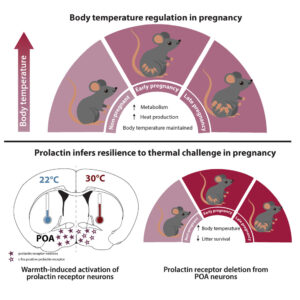 My experience of human pregnancy, while vicarious, has long associated pregnancy with uncomfortable body heat. This is both interesting and worrying to me, and so I was curious to read this new paper in Cell Reports: “Prolactin modulation of thermoregulatory circuits provides resilience to thermal challenge of pregnancy.” The title grabbed me (as a good title should), especially the phrase “resilience to thermal challenge of pregnancy.” I know that body temperature increases in early pregnancy, and I assumed it stays that way. But no. Here is how the authors frame their question in the Introduction:
My experience of human pregnancy, while vicarious, has long associated pregnancy with uncomfortable body heat. This is both interesting and worrying to me, and so I was curious to read this new paper in Cell Reports: “Prolactin modulation of thermoregulatory circuits provides resilience to thermal challenge of pregnancy.” The title grabbed me (as a good title should), especially the phrase “resilience to thermal challenge of pregnancy.” I know that body temperature increases in early pregnancy, and I assumed it stays that way. But no. Here is how the authors frame their question in the Introduction:
A mother must lose this extra metabolic heat both for herself and for her developing offspring. Despite these thermal challenges, core body temperature actually decreases in late pregnancy, suggesting that there are adaptive changes in thermoregulation to promote heat loss and to ultimately provide a safe environment for fetal development.
Prolactin, a major hormone of pregnancy, is thought to control this adaptive action by acting peripherally. In a series of manipulations of prolactin receptor function in the hypothalamus, the authors provide evidence that a major site of prolactin’s action, in thermal regulation during pregnancy, is in the brain. The authors conclude that “prolactin has a key role in regulating the thermoregulatory circuits, providing optimal conditions for successful pregnancy.”
Prolactin modulation of thermoregulatory circuits provides resilience to thermal challenge of pregnancy
In Cell Reports, 22 April 2025
From the groups of Sharon Ladyman and Rosemary S.E. Brown
Snippet by Stephen Matheson
Image credit: Graphical abstract from Ladyman et al. linked above (CC-BY-NC)